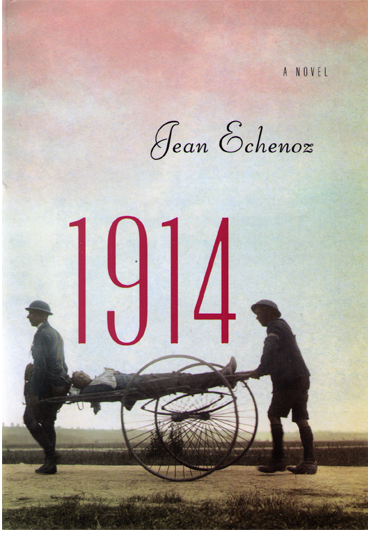
Jean Echenoz tells a very simple story in this short, compressed novel. Five men go to war; two of them return, three don’t. Two of them are brothers and in love with the same woman. The characters as such are not that interesting. What is interesting is what happens to them. Each stands for something that is particular to WWI. Charles is shot down when he joins a pilot to take pictures. The industrialization of war and the use of planes is new. Both elements were important for Echenoz and whole chapters are dedicated to them. One of the men is blinded by gas. That, too is a new and especially beastly feature of WWI. One man returns after having lost an arm. I don’t think any war saw as many mutilated men return. One of the men is executed because they mistake him for a deserter. The absurdity and farce of these decisions is made clear. One man dies during an attack. His body’s lost somewhere in the mud of no-man’s-land. All these are exemplary fates and could have turned the men into pure types, but thanks to Echenoz’s sense for detail, they are more than just types. Echenoz, as he said many times, isn’t interested in psychology. To convey a characters personality and emotions he sticks to pure “show don’t tell”. He describes the actions and the objects surrounding the characters. Both contribute to the description, one in a very realistic, the other in a more symbolic way. I think this was what fascinated me the most. Echenoz’s writing is so rigorous. There’s not one superfluous word. The vocabulary is refined, rich, and exact. He uses lists and enumerations, abstraction, numbers, irony. His writing is visual, even audiovisual because he tries to convey emotions through sounds.
1914 – 14 is one of those books that gets more interesting the more you read about it. My French paperback had about 40 pages of additional material, for which I was grateful, as an important element of Echenoz’s writing is intertexuality. I’ll give you one example. The story begins with Anthime on a hill. There’s a strong wind and suddenly he hears church bells ringing the tocsin that signals mobilisation. At the end of the scene, Anthime drives back to the village on his bicycle. He loses his book which has fallen from his bicycle and opened at the chapter “Aures habet, et non audiet”. What is interesting here is the fact that this whole scene is inspired, or rather taken from a scene in Victor Hugo’s Quatrevingt-treize – 93. It’s almost the same scene, only in Hugo’s novel, the character cannot hear the church bells, he only sees them moving. Echenoz who is interested in sound – the incredible noise is another new feature of this war – rewrote this scene, describing the sound of the bells. The book that Anthime carried with him is Hugo’s book. Allusions like these, which blend history and literature and the writing about history and literature are frequent and the closer you read, the more allusions you find.
When the book came out it was praised for its originality although Echenoz himself doesn’t seem to think it’s all that original. Here’s a quote from the book.
All this has been described a thousand times, so perhaps it’s not worthwhile to linger any longer over that sordid, stinking opera. And perhaps there’s not much point either in comparing the war to an opera, especially since no one cares about opera, even if war is operatically grandiose, exaggerated, excessive, full of longueurs, makes a great deal of noise and is often, in the end, rather boring.
I can see why critics found this original. His writing style is unique and he includes some chapters, like the one on animals, which is very different from what I’ve read in other WWI novels. The most original however is that he uses the techniques of the Nouveau Roman. One of these techniques is to explore nontraditional ways of telling a story. That’s why we find shifts in POV, intrusions of the author. Comments about the future etc. To some extent it is as much a book about writing as about war.
In an interview at the beginning of my edition, Echenoz names the three books that have influenced him the most when he wrote 14. Erich Maria Remarque’s All Quiet on the Western Front – Im Westen nichts Neues, Henry Barbusse’s Feu – Under Fire (Prix Goncourt 1916) and Gabriel Chevallier’s Peur – Fear, which we have read during an earlier Literature and War Readalong.
As short as this novel is, it’s very complex. Luckily, others have reviewed it too and much better than I.
I really liked Echenoz’s writing and would like to read more of him. Do you have suggestions?
Other reviews
*******
1914 was the second book in the Literature and War Readalong 2016. The next book is the a novel on the war in Korea, The Hunters by James Salter. Discussion starts on Tuesday 31 May, 2016. Further information on the Literature and War Readalong 2016, including the book blurbs can be found here.
